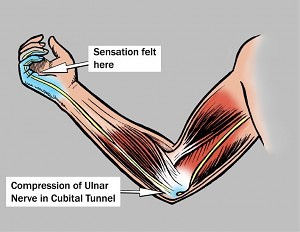Last week we discussed the ever-popular topic of carpal tunnel syndrome. This week we will take a look at a similar condition, known as cubital tunnel syndrome. This condition is not as common as carpal tunnel syndrome, but there are many people who do suffer from compression of the ulnar nerve through the cubital tunnel on the inside of the elbow (known as cubital tunnel syndrome). Most people refer to this area as the funny bone. Although most people feel that they may have bumped their elbow bone that causes the spark-like pain up and down the arm, it is the ulnar nerve that has been hit at the elbow that will cause the “funny bone” feeling.
Compression of the nerve at the inside of the elbow causes tingling in the little and ring finger. Long-term damage and compression to this nerve will cause hand weakness, especially with pinching and object manipulation, and will also demonstrate a pattern where the ring and little finger are unable to straighten at the middle knuckle on the fingers. Cubital tunnel syndrome can be caused by having the elbows bent too much or from direct pressure on the nerve at the inside of the elbow.
Someone with cubital tunnel syndrome may have noticed symptoms from time to time that come and go. Activities that often cause these problems include resting your arm on a hard surface such as a tabletop; resting your arm on a chair rest; or driving in the car with your arm resting on the doo r. A slight tingling pain begins to creep into your arm and fingers–the nerve is being compressed and “falling asleep”. More recently others may have noticed that when browsing through their phones, holding it closer to their face with the elbow or elbows bent for a period of time, the hands begin to tingle or ache. More than likely compression of the ulnar nerve at the elbow is occurring from the prolonged bent angle at the joint. Also, sleeping with the elbow flexed and compressed for a period time may leave you waking up with the hand asleep or pain tingling throughout the arm. Most cubital tunnel symptoms are related to positioning.
r. A slight tingling pain begins to creep into your arm and fingers–the nerve is being compressed and “falling asleep”. More recently others may have noticed that when browsing through their phones, holding it closer to their face with the elbow or elbows bent for a period of time, the hands begin to tingle or ache. More than likely compression of the ulnar nerve at the elbow is occurring from the prolonged bent angle at the joint. Also, sleeping with the elbow flexed and compressed for a period time may leave you waking up with the hand asleep or pain tingling throughout the arm. Most cubital tunnel symptoms are related to positioning.
It is very important to understand how and why these symptoms occur. Cubital tunnel syndrome can be corrected and the nerve can recover and repair itself if the issue is addressed sooner than later. Just as we had mentioned in the carpal tunnel blog post last week, nerve issues should not be ignored. Ignoring and putting off treatment for nerve issues can lead to chronic pain and numbness and more expensive surgery options. So pay attention to where the pain and tingling is occurring in the hand and arm. If the little and ring fingers are having pain and tingling or if fine motor skills and strength are diminishing, it is typically related an ulnar nerve compression through the cubital tunnel at the inside of the elbow.
When treated early on with therapy services, results are quick and effective. Most of the time positioning and sleeping positions can be corrected and this will make a big impact. Treatment in therapy is similar to carpal tunnel syndrome treatments. Certain modalities like Ultrasound or LASER treatment will help to regenerate the nerve or decrease inflammation in the area. Specific nerve gliding exercises can also help to alleviate compression and allow the nerve recover. Kinesio taping, preventative splinting at night, or padding during the day on the elbow may also be necessary for a proper treatment and recovery.
Contact Alexandria Rehabilitation at 320.335.2515 for more information about your specific situation, or to make an appointment with YOUR upper extremity specialist! We can also be reached by email at [email protected].
Latest posts by Amos Hartsell (see all)
- Playing Pickleball - June 12, 2024
- Tips for Safe Bike Riding this Summer - June 4, 2024
- Remember: You have a choice in where you receive your healthcare - April 12, 2017
